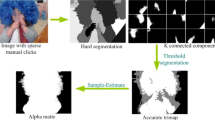Abstract
Given an image, digital matting consists in extracting a foreground element from the background. Standard methods are initialized with a trimap, a partition of the image into three regions: a definite foreground, a definite background, and a blended region where pixels are considered as a mixture of foreground and background colors. Recovering these colors and the proportion of mixture between both is an under-constrained inverse problem, sensitive to its initialization: one has to specify an accurate trimap, leaving undetermined as few pixels as possible.
First, we propose a new segmentation scheme to extract an accurate trimap from just a coarse indication of some background and/or foreground pixels. Standard statistical models are used for the foreground and the background, while a specific one is designed for the blended region. The segmentation of the three regions is conducted simultaneously by an iterative Graph Cut based optimization scheme. This user-friendly trimap is similar to carefully hand specified ones.
As a second step, we take advantage of our blended region model to design an improved matting method coherent. Based on global statistics rather than on local ones, our method is much faster than standard Bayesian matting, without quality loss, and also usable with manual trimaps.
Preview
Unable to display preview. Download preview PDF.
Similar content being viewed by others
References
Smith, A.R., Blinn, J.F.: Blue screen matting. In: 23rd annual conference on Computer graphics and interactive techniques, pp. 259–268. ACM Press, New York (1996)
Ruzon, M., Tomasi, C.: Alpha estimation in natural images. In: CVPR (2000)
Chuang, Y.Y., Curless, B., Salesin, D.H., Szeliski, R.: A bayesian approach to digital matting. In: CVPR, vol. 2, pp. 264–271 (2001)
Wexler, Y., Fitzgibbon, A., Zisserman, A.: Bayesian estimation of layers from multiple images. In: Heyden, A., Sparr, G., Nielsen, M., Johansen, P. (eds.) ECCV 2002. LNCS, vol. 2352, pp. 487–501. Springer, Heidelberg (2002)
Perez, P., Gangnet, M., Blake, A.: Poisson image editing. In: SIGGRAPH (2003)
Sun, J., Jia, J., Tang, C., shum, H.: Poisson matting. In: SIGGRAPH (2004)
Blake, A., Rother, C., Brown, M., Perez, P., Torr, P.: Interactive image segmentation using an adaptive GMMRF model. In: Pajdla, T., Matas, J(G.) (eds.) ECCV 2004. LNCS, vol. 3021, pp. 428–441. Springer, Heidelberg (2004)
Rother, C., Kolmogorov, V.: Grabcut - interactive foreground extraction using iterated graph cuts. In: SIGGRAPH (2004)
Boykov, Y., Jolly, M.P.: Interactive graph cuts for optimal boundary and region segmentation of objects in n-d images. In: ICCV, 105–112 (2001)
Kolmogorov, V., Zabih, R.: What energy functions can be minimized via graph cuts? IEEE Trans. on Pattern Analysis and Machine Intelligence, 65–81 (2004)
Mitsunaga, T., Yokoyama, T., Totsuka, T.: Autokey: Human assisted key extraction. In: SIGGRAPH (1995)
Xiao, J., Shah, M.: Accurate motion layer segmentation and matting. In: CVPR (2005)
Osher, S., Sethian, J.: Fronts propagating with curvature dependent speed: algorithms based on the Hamilton–Jacobi formulation. Journal of Computational Physics 79, 12–49 (1988)
Osher, S., Paragios, N. (eds.): Geometric Level Set Methods in Imaging, Vision and Graphics. Springer, Heidelberg (2003)
Brox, T., Rousson, M., Deriche, R., Weickert, J.: Unsupervised segmentation incorporating colour, texture, and motion. In: Petkov, N., Westenberg, M.A. (eds.) CAIP 2003. LNCS, vol. 2756, pp. 353–360. Springer, Heidelberg (2003)
Kadir, T., Brady, M.: Unsupervised non-parametric region segmentation using level sets. In: Proceedings of ICCV 2003 (2003)
MacQueen, J.: Some methods for classification and analysis of multivariate observations. In: Cam, L.M.L., Neyman, J. (eds.) Proceedings of the Fifth Berkeley Symposium on Mathematical Statistics and Probability, vol. 1, pp. 281–297 (1967)
Descombes, X., Sigelle, M.: Estimating gaussian markov random field parameters in a nonstationary framework: Application to remote sensing imaging. IEEE Trans. on Image Processing 8, 490–503 (1999)
Orchard, M.T., Bouman, C.A.: Color Quantization of Images. IEEE Trans. on Signal Processing 39, 2677–2690 (1991)
McLachlan, G., Krishnan, T.: The EM algorithm and extensions. Wiley, New York (1997)
McLachlan, G., David, P.: Finite Mixture Models. Wiley, New York (2000)
Figueiredo, M., Leitao, J.M.N., Jain, A.K.: On fitting mixture models. Energy Minimization Methods in Computer Vision and Pattern Recognition, 54–69 (1999)
Ueda, N., Nakano, R., Ghahramani, Z., Hinton, G.E.: Smem algorithm for mixture models. Neural Computation 12, 2109–2128 (2000)
Rousson, M., Brox, T., Deriche, R.: Active unsupervised texture segmentation on a diffusion based space. In: International Conference on Computer Vision and Pattern Recognition, Madison, Wisconsin, USA, vol. 2, pp. 699–704 (2003)
Juan, O., Keriven, R., Postelnicu, G.: Stochastic Motion and the Level Set Method in Computer Vision: Stochastics Active Contours. International Journal of Computer Vision (in press)
Boykov, Y., Veksler, O., Zabih, R.: Fast Approximate Energy Minimization via Graph Cuts. IEEE Trans. on Pattern Analysis and Machine Intelligence 23, 1222–1239 (2001)
Boykov, Y., Kolmogorov, V.: Computing geodesics and minimal surfaces via graph cuts. In: ICCV (2003)
Kitamoto, A.: The moments of the mixel distribution and its application to statistical image classification. In: Amin, A., Pudil, P., Ferri, F., Iñesta, J.M. (eds.) SPR 2000 and SSPR 2000. LNCS, vol. 1876, pp. 521–531. Springer, Heidelberg (2000)
Kitamoto, A., Takagi, M.: Area proportion distribution – relationship with the internal structure of mixels and its application to image classification. Systems and Computers in Japan 31, 57–76 (2000)
Ishikawa, H.: Exact optimization for markov random fields with convex priors. IEEE Trans. on Pattern Analysis and Machine Intelligence 25, 1333–1336 (2003)
Author information
Authors and Affiliations
Editor information
Editors and Affiliations
Rights and permissions
Copyright information
© 2005 Springer-Verlag Berlin Heidelberg
About this paper
Cite this paper
Juan, O., Keriven, R. (2005). Trimap Segmentation for Fast and User-Friendly Alpha Matting. In: Paragios, N., Faugeras, O., Chan, T., Schnörr, C. (eds) Variational, Geometric, and Level Set Methods in Computer Vision. VLSM 2005. Lecture Notes in Computer Science, vol 3752. Springer, Berlin, Heidelberg. https://doi.org/10.1007/11567646_16
Download citation
DOI: https://doi.org/10.1007/11567646_16
Publisher Name: Springer, Berlin, Heidelberg
Print ISBN: 978-3-540-29348-4
Online ISBN: 978-3-540-32109-5
eBook Packages: Computer ScienceComputer Science (R0)




